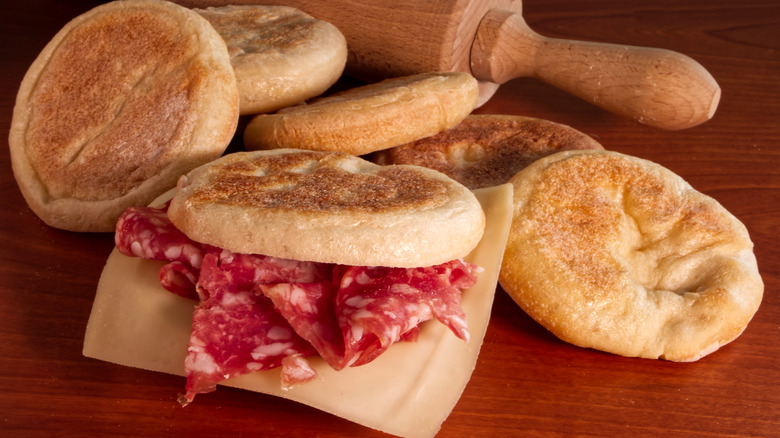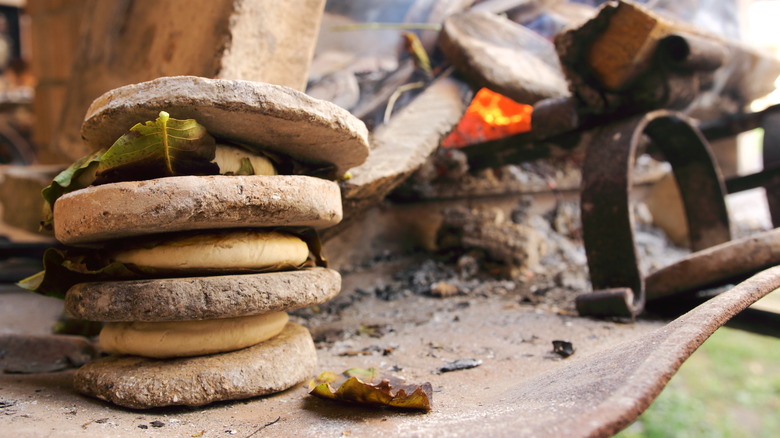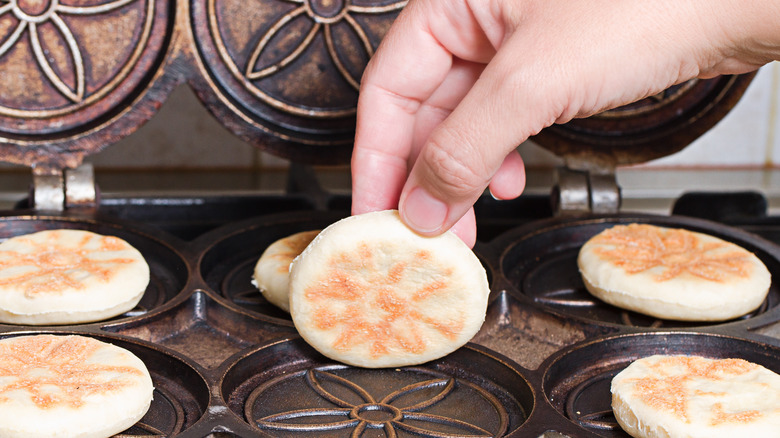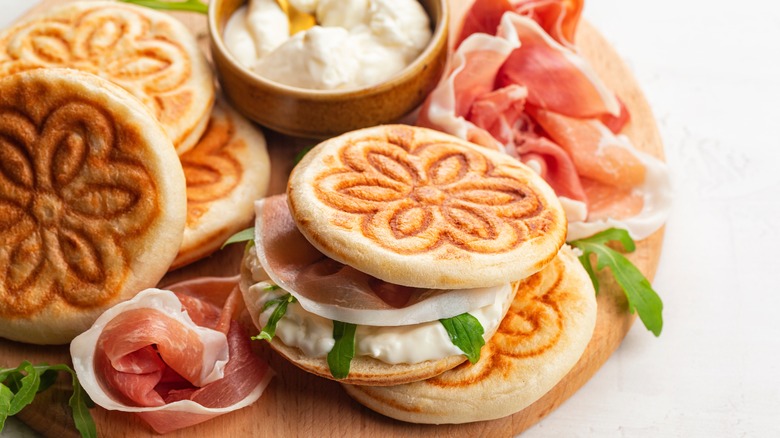The Versatile Italian Street-Food Sandwich You Can Order With Meat Or Nutella
Imagine strolling along the narrow streets of an old town in Italy, admiring the architecture, and visiting quaint shops. All the walking and sightseeing make you hungry, so you opt for a quick meal of street food. You discover a shop selling tigelle sandwiches, filled with flavorful cured meat and cheese or creamy and rich Nutella.
What to pick: savory or sweet? Why not one of each? This Italian street food uses tigelle bread, which National Geographic compares to a mix of a pancake and an English muffin. Many people choose to eat the warm tigelle by itself because of its wonderful flavor and texture, which when slightly browned has a crispy exterior and a soft inside. Others opt to slice open the round bread and fill it with cheese, meat, or a sweet spread. This versatile sandwich has a rich history, enjoyed by residents for centuries but still not very well-known beyond Italy.
The foundation of the sandwich: tigelle bread
To appreciate a tigelle sandwich, first, you need to understand the bread. It originated in the Apennine Mountains, near Modena, Italy, according to National Geographic, at a time when farming families would bake the evening bread together over a fire. These families would bake balls of dough called crescentine in clay molds that were known as tigelle (per Art Viva). The tigelle molds would be hot when the dough was placed in them, and then they would be stacked on top of one another, which would make baking the bread even faster, according to National Geographic. After removing the bread from the molds, it would be divided and covered with a topping similar to pesto and cheese.
Eventually, the bread became known simply as tigelle (but some people still refer to it as crescentine). The first time tigelle was written about was in the 13th century under the oversight of Emperor Frederick II, the Stupor Mundi, according to Philosokitchen. Tigelle is primarily a regional food in Italy, found in Emilia-Romagna. The cities of Bologna and Modena are located in Emilia-Romagna. After defeating the area, the ruler fell in love with the popular regional dish.
How to make tigelle bread
Long gone are the clay pots and open hearth used to make tigelle. Nowadays, the bread is made in iron or aluminum presses, which like the old clay molds, are often decorated with a symbol, such as a flower, so the design is pressed into the bread as it bakes, according to National Geographic. A recipe for tigelle from Silvio Cicchi calls for flour, cold water, milk, lard (which can be replaced with extra virgin olive oil), yeast, and salt. The lard and milk are used in order to keep the tigelle soft for days after it has been baked. However, American chef Nathan Anda prefers to use olive oil, which he said gave his tigelle the right texture for the sandwiches he wished to make, which included prosciutto and other toppings.
Once the dough has been kneaded, it will become elastic like pizza dough. The dough can be rolled out and then made into discs, as is done by Silvio Cicchi, or it can be placed on an electric tigelle press.
A stuffed sandwich
In addition to the bread being called tigelle, so is the popular Italian sandwich made with the bread. Great Italian Chefs says the bread is usually taken out of the pan, sliced open, and then stuffed right away with different fillings. These can be savory, such as cured meats or cheese, as well as something sweet like Nutella. Philosokitchen says some of the most commonly used cheeses for tigelle are giuncata, stracchino, and parmigiano reggiano. A popular spread for tigelle is pesto Modenese, which is made from lard, garlic, and rosemary.
Tigelle has proven to be versatile and can be made for dessert, as well, with fillings of chocolate hazelnut spread, mascarpone cream, or blueberry marmalade, per Philosokitchen. Great Italian Chefs' recipe sticks to the savory fillings and recommends meats such as salami and cheeses of a person's choosing. Sanpellegrino says you can't go wrong with stuffing tigelle with any cured meats or sausages, such as mortadella, salami, or ham.
Whether you are in a sweet or savory mood, simple or complex, a tigelle sandwich can satisfy your appetite and taste buds.



